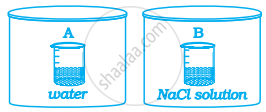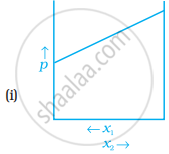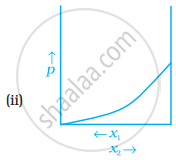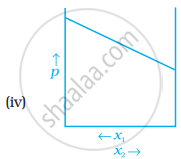Advertisements
Advertisements
प्रश्न
Why is the vapour pressure of an aqueous solution of glucose lower than that of water?
उत्तर
In pure liquid water the entire surface of liquid is occupied by the molecules of water. When a non volatile solute, for example glucose is dissolved in water, the fraction of surface covered by the solvent molecules gets reduced because some positions are occupied by glucose molecules. As a result number of solvent molecules escaping from the surface also gets reduced, consequently the vapour pressure of aqueous solution of glucose is reduced.
APPEARS IN
संबंधित प्रश्न
30 g of urea (M = 60 g mol−1) is dissolved in 846 g of water. Calculate the vapour pressure of water for this solution if vapour pressure of pure water at 298 K is 23·8 mm Hg.
The vapour pressure of pure benzene at a certain temperature is 0.850 bar. A non-volatile, nonelectrolyte solid weighing 0.5 g is added to 39.0 g of benzene (molar mass 78 g/mol). The vapour pressure of the solution then is 0.845 bar. What is the molecular mass of the solid substance?
The vapour pressure of pure benzene at 25°C is 640 mm Hg and that of solution of solute A is 630 mm Hg. The molality of a solution is:
The solubility of a solid in a liquid is significantly affected by temperature changes.
\[\ce{Solute + Solvent -> Solution}\]
The system being in a dynamic equilibrium must follow Le-chatelier’s principle.
Considering the Le-chatelier’s principle which of the following is correct?
At a particular temperature, the vapour pressures of two liquids A and B are respectively 120 and 180 mm of mercury. If 2 moles of A and 3 moles of B are mixed to form an ideal solution, the vapour pressure of the solution at the same temperature will be (in mm of mercury):
The vapour pressure of a solvent decreases by 10 mm of Hg when a non-volatile solute was added to the solvent. The mole fraction of the solute in the solution is 0.2. What should be the mole fraction of the solvent if the decrease in the vapour pressure is to be 20 mm of Hg?
Two beakers of capacity 500 mL were taken. One of these beakers, labelled as “A”, was filled with 400 mL water whereas the beaker labelled “B” was filled with 400 mL of 2 M solution of NaCl. At the same temperature both the beakers were placed in closed containers of same material and same capacity as shown in figure.
At a given temperature, which of the following statement is correct about the vapour pressure of pure water and that of NaCl solution.
For a binary ideal liquid solution, the variation in total vapour pressure versus composition of solution is given by which of the curves?



The vapour pressure of a 5% aqueous solution of non-volatile organic substance at 373 k is 745 mm. calculated the molecular mass of the solute
The vapour pressures of pure liquids A and B are 400 and 600 mm Hg, respectively at 298 K On mixing the two liquids, the sum of their initial volumes is equal to the volume of the final mixture. The mole fraction of liquids B is 0.5 in the mixture. The vapour pressure of the final solution, the mole fractions of components A and B in vapour phase, respectively are ______.
